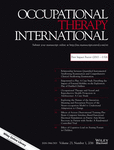Effects of Action Observational Training Plus Brain–Computer Interface-Based Functional Electrical Stimulation on Paretic Arm Motor Recovery in Patient with Stroke: A Randomized Controlled Trial
Abstract
The purpose of this study was to investigate whether action observational training (AOT) plus brain–computer interface-based functional electrical stimulation (BCI-FES) has a positive influence on motor recovery of paretic upper extremity in patients with stroke. This was a hospital-based, randomized controlled trial with a blinded assessor. Thirty patients with a first-time stroke were randomly allocated to one of two groups: the BCI-FES group (n = 15) and the control group (n = 15). The BCI-FES group administered to AOT plus BCI-FES on the paretic upper extremity five times per week during 4 weeks while both groups received conventional therapy. The primary outcomes were the Fugl-Meyer Assessment of the Upper Extremity, Motor Activity Log (MAL), Modified Barthel Index and range of motion of paretic arm. A blinded assessor evaluated the outcomes at baseline and 4 weeks. All baseline outcomes did not differ significantly between the two groups. After 4 weeks, the Fugl-Meyer Assessment of the Upper Extremity sub-items (total, shoulder and wrist), MAL (MAL-Activity of Use and Quality of Movement), Modified Barthel Index and wrist flexion range of motion were significantly higher in the BCI-FES group (p < 0.05). AOT plus BCI-based FES is effective in paretic arm rehabilitation by improving the upper extremity performance. The motor improvements suggest that AOT plus BCI-based FES can be used as a therapeutic tool for stroke rehabilitation. The limitations of the study are that subjects had a certain limited level of upper arm function, and the sample size was comparatively small; hence, it is recommended that future large-scale trials should consider stratified and lager populations according to upper arm function. Copyright © 2015 John Wiley & Sons, Ltd.




